Why Do I Have To Recover Webpage So Often
Z7_3054ICK0KGTE30AQO5O3KA30N0
hp-concentra-wrapper-portlet
![]() Actions
Actions
HP PCs - Internet Explorer Not Working as Expected (Windows 10, 8)
This document applies to HP and Compaq computers and tablets with Internet Explorer versions 10 and 11, and Windows 10 or Windows 8.
Issues can occur while using the Microsoft Internet Explorer (Internet Explorer) web browser software, such as the appearance of your Internet not working, you cannot connect to the Internet, slow Internet, or no Internet. Use the first few steps to resolve most issues. If the issue is not resolved, select the section that corresponds to the problem you are having in Internet Explorer. If you cannot find a section that best matches your problem, use the section on repairing Internet Explorer.
Step 1: Reset Internet Protocol (IP) settings
Perform the steps in this section to reset your Internet Protocol settings in Windows. Resetting TCP/IP (Internet Protocol) can resolve issues such as always receiving a Page cannot be displayed message or 404 messages. Use the following steps to reset TCP/IP:
-
Move the mouse pointer to the lower left corner of the screen, right-click, and select Command Prompt (Admin) from the menu.
Figure : Command Prompt (Admin)
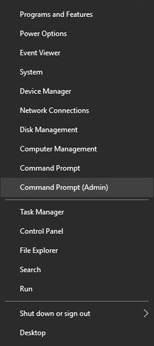
-
At the command prompt, type the following: netsh int ip reset, and then press Enter.
This command returns a series of responses that end with OK!, and then a request to restart the computer.
Figure : IP reset
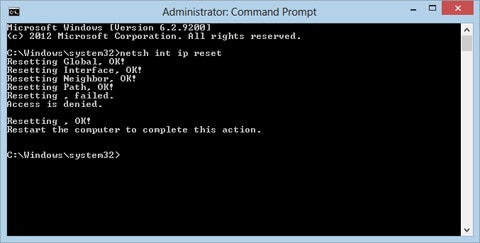
-
At the command prompt, type the following: netsh winsock reset, and then press Enter.
A success message is shown when the command passes.
Figure : Reset the Winsock Catalog

-
Restart the computer. IP is reset.
Step 2: Reset Internet Explorer settings
Resetting Internet Explorer settings can resolve many types of problems.
caution:After using these steps, you might need to re-enter information in trusted webpages, such as passwords or personal information.
-
Search Windows for Internet Options and click Internet Options in the search results.
-
Click the Advanced tab, and then click Reset.
Figure : Internet Options: Reset button
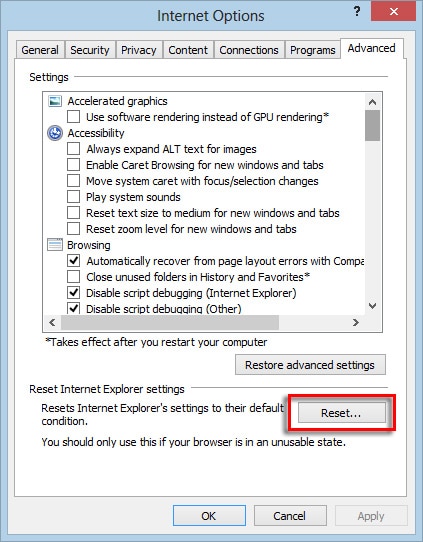
-
When done, close all open Internet Explorer windows, reopen Internet Explorer, and then try to view the webpage again.
Step 3: Use System File Checker to repair Internet Explorer
Follow these steps to use System File Checker to scan the system and repair many problems with Internet Explorer.
caution:After using these steps, you might have to re-enter information in trusted webpages, such as passwords or personal information.
note:If you cannot repair Internet Explorer using the following steps, get the latest version of Internet Explorer from Microsoft. For more information, go to the Microsoft Internet Explorer download webpage (in English).
-
Move the mouse pointer to the lower left corner of the screen, right-click, and select Command Prompt (Admin) from the menu.
Figure : Command Prompt (Admin)

-
A User Account Control prompt window opens. Click Yes to allow Windows Command Processor to make changes to your device.
-
At the command line prompt, type the following: SFC /SCANNOW, and then press Enter.
Figure : System File Checker

A window opens giving you the status of the files it found and fixed.
Step 4: Uninstall Internet Explorer updates
If Internet Explorer was updated on your computer, you can go back to the previous version to see if that resolves the issue. Follow these steps to uninstall Internet Explorer updates:
-
Search Windows for Programs and Features and click Programs and Features in the search results.
-
Click View installed updates.
Figure : Viewing the installed updates
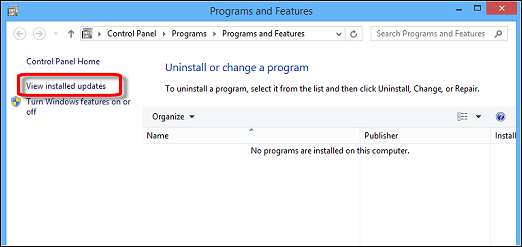
-
Select the Internet Explorer update from the list of installed updates. It might be listed under Microsoft Windows.
-
Click Uninstall and follow the messages as they open to uninstall Internet Explorer.
Step 5: Open Internet Explorer without add-ons
Over time, browser add-ins accumulate and can produce spyware problems, error messages, or Internet Explorer startup problems. Start Internet Explorer without any third-party add-ons:
-
Search Windows for Run and click Run in the search results.
-
Type the following into the Open field: iexplore -extoff
Figure : iexplore -extoff

-
Click OK.
Internet Explorer opens without add-ons.
Step 6: Find a fix that matches your computer's symptom
Various issues can occur while using Microsoft Internet Explorer (Internet Explorer) web browser software. Read the following sections for one that corresponds to the problem you are having in Internet Explorer. If you cannot find a section that best matches your problem, use the section on repairing Internet Explorer.
Spyware and browser hijacking issues
If the computer becomes slow when connecting to the Internet, your home page always changes to a page you do not want, unwanted desktop links display, advertising windows pop-up repeatedly, or search bars surprisingly display, your computer has spyware or adware.
Internet Explorer has stopped working or is running slow
Internet Explorer is running slow or the following message displays in Internet Explorer:
Internet Explorer has stopped working
This error can be caused by hardware or drivers that are not compatible with hardware acceleration. To resolve this error, run Internet Explorer in Software Rendering Mode.
-
Search Windows for Internet Options and click Internet Options in the search results.
-
On the Advanced tab, place a check next to Use software rendering instead of GPU rendering.
Figure : Use software rendering

-
Click OK.
-
Restart the computer and attempt to browse the Internet.
Internet Explorer crashes when opened
Use these steps if Internet Explorer opens, then immediately closes.
Step 1: Perform a clean boot
Disable startup services, and then restart the computer.
-
In Windows, search for and open System Configuration.
The System Configuration dialog box opens.
-
In the System Configuration dialog box, click the Services tab.
-
Click the Hide all Microsoft services check box, then click Disable all.
-
Click the Startup tab.
-
Click Open Task Manager.
The Task Manager window opens.
-
In the Task Manager window, click the Startup tab.
-
Click each enabled startup item, then select Disable.
-
Close Task Manager.
-
In the Services tab of the System Configuration dialog box, click OK.
-
Restart the computer.
Step 2: Turn off all add-ons and extensions
Disable Internet Explorer add-ons and extensions.
-
Search Windows for Run and click Run in the search results.
-
Type the following into the Open field: iexplore -extoff
Figure : iexplore -extoff

-
Click OK.
Internet Explorer opens without add-ons.
Step 3: Use System File Checker to repair Internet Explorer
Repair Internet Explorer using the System File Checker (SFC).
-
Move the mouse pointer to the lower left corner of the screen, right-click, and select Command Prompt (Admin) from the menu.
Figure : Command Prompt (Admin)

-
A User Account Control prompt window opens. Click Yes to allow Windows Command Processor to make changes to your device.
-
At the command line prompt, type the following: SFC /SCANNOW, and then press Enter.
Figure : System File Checker

A window opens giving you the status of the files it found and fixed.
-
If SFC results indicate that it did not find any integrity violations, proceed as normal.
-
If SFC results indicate that it found corrupt files and successfully fixed them, restart PC and check the problem again.
-
If SFC results indicate that it found corrupt files but was unable to fix them, perform DISM, wait for it to finish, then perform SFC again.
Type: DISM /ONLINE /CLEANUP-IMAGE /RESTOREHEALTH
-
Step 4: Re-install Internet Explorer
Remove then re-install Internet Explorer.
-
Hold the Windows key + x, and select Programs and Features.
-
Click Turn Windows Features On or Off.
-
Uncheck Internet Explorer 11 on the list, then click Apply.
-
Internet Explorer uninstalls.
-
Restart the PC.
-
Repeat the steps above, this time placing a check mark next to Internet Explorer 11.
-
Internet Explorer is re-installed. Restart the PC again to apply changes.
Images do not display
If images do not load into webpages, use the following steps:
Figure : Example of missing graphic placeholder

-
Search Windows for Internet Options and click Internet Options in the search results.
-
Click the Advanced tab and select Show pictures under Multimedia.
-
If Show pictures is not selected, check the box next to Show pictures, click OK, and reopen Internet Explorer.
Figure : Show pictures
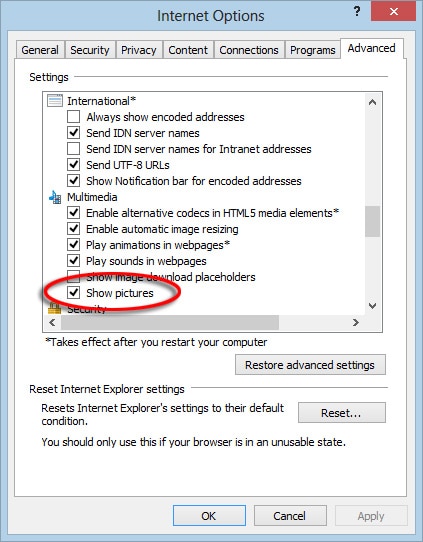
Images now display when browsing webpages.
I keep getting asked to install ActiveX controls after I installed them
If you are repeatedly asked to install ActiveX controls from the same website, turn off ActiveX Filtering.
Click Tools from the Menu bar (if the Menu bar is not displayed, press Alt to open it), and then click ActiveX Filtering to remove the check. ActiveX Filtering is disabled when the check is removed.
Error message "Enable ActiveX" or "Your current security settings prohibit the running of ActiveX controls" appears
Error: Page Cannot Be Displayed
When opening Internet Explorer after connecting to the Internet, the message Page Cannot be Displayed displays. Perform the following steps until this error message is resolved:
-
The webpage that you are trying to reach might be out of service. Try visiting different websites to see if this message still displays from other sites. If visiting other sites also cause the message, continue using these steps.
-
If the page display problems persist, continue.
-
Search Windows for Run and click Run in the search results.
-
Type the following into the Open field: regsvr32 softpub.dll
Figure : regsvr32 softpub.dll
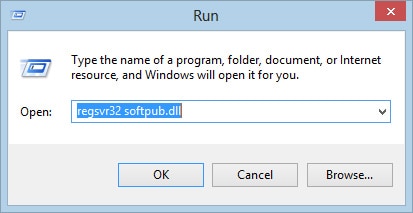
-
Click OK.
If you typed the item correctly, a message displays stating that the RegSrv32 command succeeded.
Figure : Success message
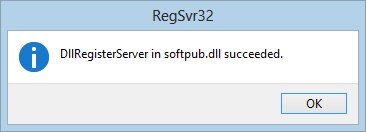
-
Search Windows for Run and click Run in the search results.
-
Type the following into the Open field: regsvr32 urlmon.dll
If you typed the item correctly, a message displays stating that the RegSrv32 command succeeded.
-
Click OK.
A success window displays.
-
Restart the computer and then try browsing the Internet again.
If the error persists, continue.
-
Open Internet Explorer and go to the website that causes it to stop working.
-
Press the Alt key to open the Menu bar, click Tools, and then click Compatibility View settings.
Figure : Compatibility View Settings
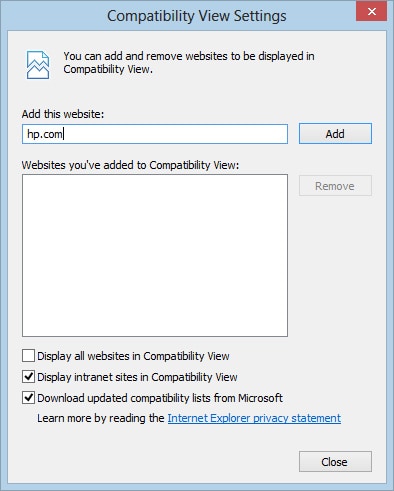
-
Make sure that the box next to Display all websites in Compatibility View is checked.
Figure : Compatibility View Settings with Display all websites in Compatibility View checked
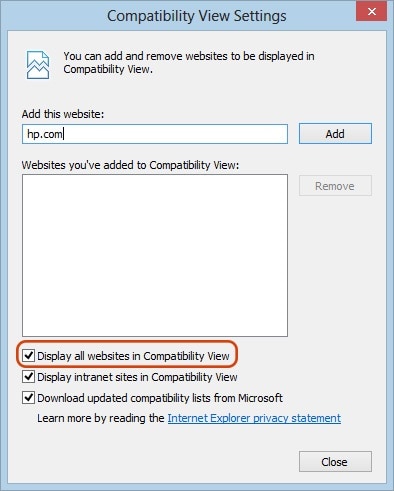
-
Click Close and then restart the computer and then try browsing the Internet again.
Error: Enable ActiveX or Your current security setting prohibit the running or ActiveX controls
To resolve this issue, refer to the Resetting Internet Explorer settings section of the HP support document Resolving Internet Explorer Issues.
Error: Internet Explorer has encountered an error and needs to close
To resolve this error, make the following changes in Internet Explorer:
caution:After using these steps, you might have to re-enter information in trusted webpages, such as passwords or personal information.
First, reset Internet Explorer to disable 3rd party add-ons that might be causing problems. If the error continues, use the steps in the following section to delete your temporary Internet files:
Delete browsing history and cookies, and managing add-ons
Use these steps to delete browsing history and cookies, and to manage add-ons in Internet Explorer:
-
Search Windows for Internet Options and click Internet Options in the search results.
-
On the General tab under Browsing History, click Delete.
Figure : Internet Options
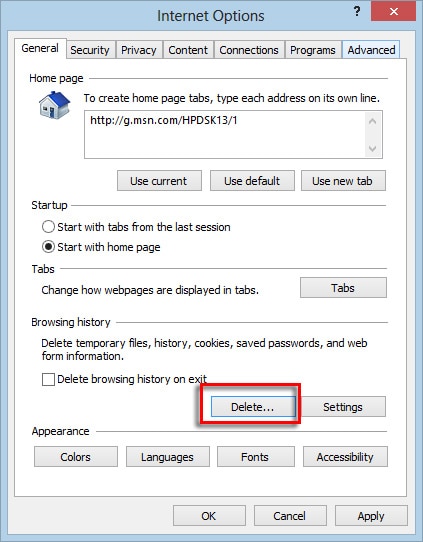
-
Make sure that the box next to Cookies and website data is checked.
Figure : Delete cookies and website data

-
Click Delete.
-
In the Internet Options window, click the Programs tab, and then click the Manage add-ons button.
Figure : Programs
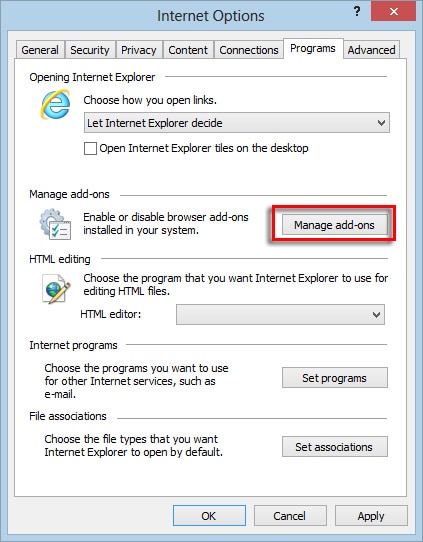
Add-ons are ActiveX controls that change the way Internet Explorer functions. These can be toolbars, plug-ins, and other code that can interfere with the operation of Internet Explorer.
-
Select any suspicious add-ons from the name list, and then click Disable to prevent the add-on from opening when Internet Explorer is opened. Click Close when finished.
Figure : Manage Add-ons
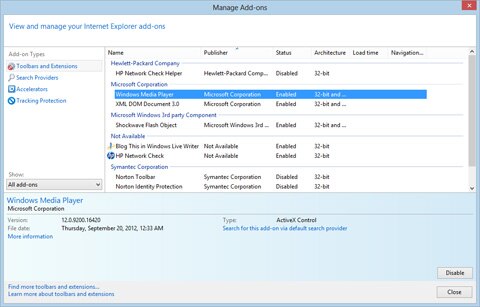
-
In the Internet Options window, click the Advanced tab.
-
Under Browsing, remove the check next to Enable third-party browser extensions (requires restart).
Figure : Enable third-party browser extensions
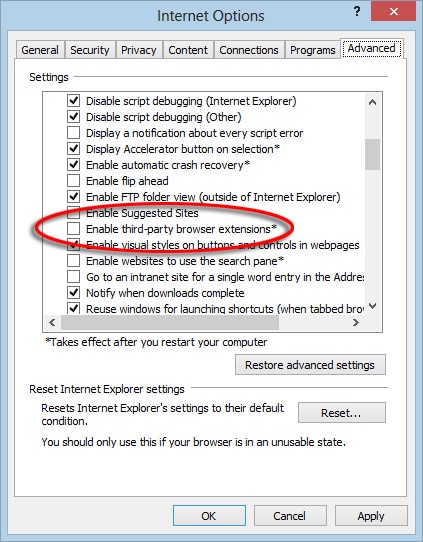
note:
Preventing third-party browser extensions removes search toolbars, gadgets, and Symantec's phishing filter notification from the top menu.
-
Click OK.
-
Restart the computer.
The error no longer displays.
note:
These errors are probably caused by browser extensions that were added by spyware or adware. If you want to use third-party browser extensions, read the HP support document HP PCs - Computer Might Be Infected by a Virus or Malware (Windows 10, 8), to learn about removing spyware and adware and how to better protect your computer from these types of software. When protected, you can re-enable the use of third-party extensions.
Error: A Runtime error has occurred. Do you wish to debug?
This error occurs when Internet Explorer cannot use the script from a webpage. These errors are harmless, but can happen frequently and become annoying. You can turn the messages off by disabling script debugging.
Figure : Runtime error message
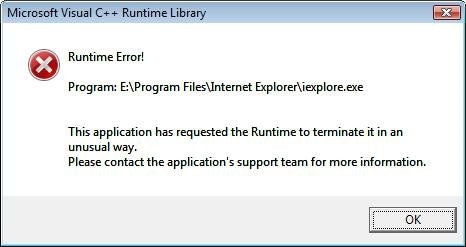
Use the following steps to manually disable script debugging:
-
Search Windows for Internet Options and click Internet Options in the search results.
-
Click the Advanced tab.
-
Remove the checkmark from Display a notification about every script error.
Figure : Advanced tab

-
Select Disable script debugging (for both Internet Explorer and Other).
-
Click OK and restart Internet Explorer.
Unable to close Internet Explorer
If you cannot close Internet Explorer by pressing the X in the upper right corner, then an add-on is probably keeping the Window open. Reset Internet Explorer to disable add-ons.
Unable to view secure websites (such as online banking)
Normal webpages can be viewed, but secure webpages, such as shopping pages or pages that deal with personal information, cannot be viewed. To view secure webpages, first reset the SSL encryption, and then install the Microsoft Windows Small Business Server 2003 self-signed certificate.
Figure : Secure website

Step 1: Reset encryption
Reset SSL encryption so secure pages can be viewed.
-
Search Windows for Internet Options, and then click Internet Options in the search results.
-
Click the Security tab.
-
Select Trusted Sites.
-
If available, click the Default level button.
Figure : Security tab
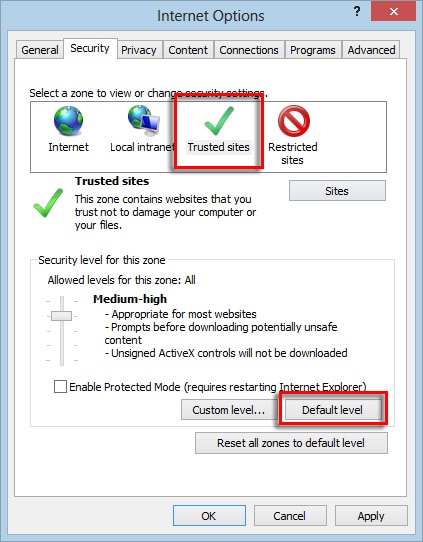
-
Click the Advanced tab, and then scroll to the Security Options section.
-
Select Use SSL 2.0 and Use SSL 3.0 if they are not already selected.
Figure : Use SSL
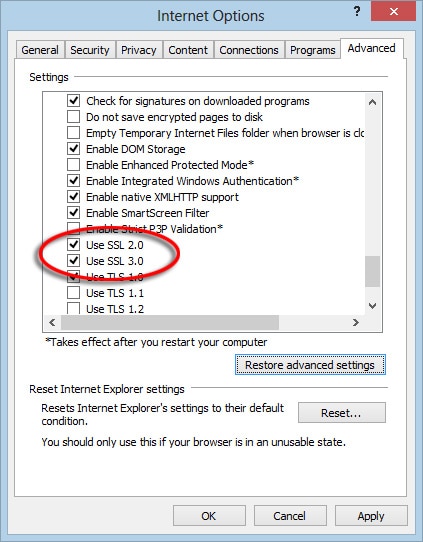
-
Click the Content tab.
-
Click the Clear SSL state button.
Figure : Clear SSL state

-
Click Apply, and then browse to a secure webpage and attempt to access the page. If you cannot access the secure webpage, continue with these steps.
-
Re-register the .dll files:
-
Search Windows for Run, and then click Run in the search results.
-
Type the following into the Open field: regsvr32 softpub.dll
Figure : Run regsvr32 softpub.dll

-
Click OK.
If you typed the item correctly, a message displays stating that the RegSrv32 command succeeded.
Figure : Success message

-
Repeat for the following items:
-
regsvr32 wintrust.dll
-
regsvr32 initpki.dll
-
regsvr32 dssenh.dll
-
regsvr32 rsaenh.dll
-
regsvr32 gpkcsp.dll
-
regsvr32 sccbase.dll
-
regsvr32 slbcsp.dll
-
regsvr32 cryptdlg.dll
-
-
Restart the computer.
-
Browse to a secure webpage, and then attempt to access the page. If the issue persists, continue to the next step.
Step 2: Install the Microsoft Windows Small Business Server 2003 self-signed certificate
Use your browser to install the Microsoft Windows Small Business Server 2003 (Windows SBS) self-signed certificate.
-
In the error message window, click Continue to this website (not recommended).
A red address bar and a certificate warning display.
-
Click the Certificate Error button to open the information window.
-
Click View Certificates, and then click Install Certificate.
A warning message displays.
-
Click Yes to install the certificate.
You can now access secure webpages.
I cannot find Internet Explorer in Windows in Windows 8
Internet Explorer is a feature in Windows 8. Additional software is not required to install it on your system. If you are no longer able to find the icons on the Start screen or Desktop, the component may have been disabled. Check the following to verify the feature is not disabled and to re-enable it.
-
Search Windows for Windows features and click Windows features in the search results.
-
Click Turn Windows features on or off.
-
In the results list, click Turn Windows features on or off.
-
Check the list to make sure the Internet Explorer 10 or the internet Explorer 11 box is checked.
Figure : Windows Features
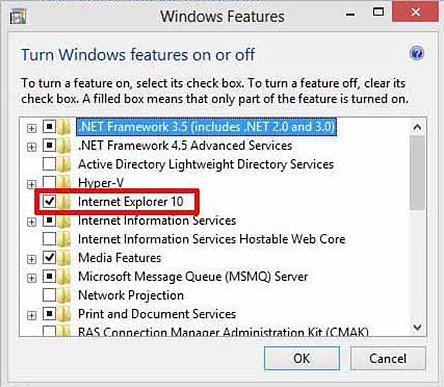
After selecting the check box, Internet Explorer should reappear in both the Start screen and desktop.
Missing File Menu, Address bar, or all menu items
Use these steps to restore missing menu items:
-
If most of the menu items are missing, press F11. Full screen mode was enabled.
-
If the file menu (Menu bar) is missing, press the Alt key to open the file menu. To permanently display the file menu, right-click anywhere in the top area of the Internet Explorer window, and then select Menu bar.
-
If any other toolbar is missing, click View, Toolbars, and then select the name of the toolbar that is missing. Any toolbar with a check is always displayed.
No sound from Internet Explorer webpages
If you can hear sounds from your computer, but do not hear sounds from Internet Explorer webpages, such as when viewing videos, then follow these steps:
-
From the media player in the webpage, click the speaker or volume setting and to unmute and to raise the volume to a higher setting.
Figure : Media player mute setting

-
If you still cannot hear sounds, search Windows for Adjust Speaker Volume and click Adjust Speaker Volume in the search results.
The volume mixer window should open. If not, click Mixer to open the volume mixer.
-
In the Internet Explorer column, click the speaker icon to unmute the volume and move the volume slider up to a normal level.
note:
You must be viewing a website that is playing audio, such as when viewing a video from YouTube, to see the Internet Explorer column in the mixer window. If you do not see the column, play a video from a website.
Figure : Adjusting volume for Internet Explorer in the Volume Mixer window
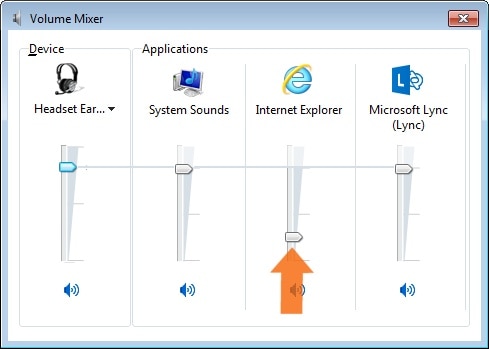
Not all of the items display when I am checking out from online stores
If there are items missing from the page when you check out from online stores in Internet Explorer, turn off the Tracking Protection List:
-
Search Windows for Manage browser add-ons and click Manage browser add-ons in the search results.
-
Click Tracking Protection.
-
Select the list, and then click Disable.
Figure : Tracking Protection

All of the items now display on the page.
Internet Explorer stops working when I visit websites with a Java plug-in
Use one of the following steps to open websites with a Java plug-in:
-
Update Java on the computer. Visit www.java.com (in English).
-
Add the website to the compatibility view list:
-
Open the Windows Desktop.
-
Open Internet Explorer and go to the website that causes it to stop working.
-
Press the Alt key to open the Menu bar, click Tools, and then click Compatibility View settings.
Figure : Compatibility View Settings

-
Enter the URL for the website, then click Add.
-
Unable to open PDF files in Internet Explorer 10
Use the following steps to troubleshoot if you are cannot open PDF files in Internet Explorer. Test after each step, closing and then reopening Internet Explorer, and then trying to open the PDF file.
-
Disable Internet Explorer add-ons and add them back one by one to determine if one of them is preventing the PDF file from displaying.
-
In Internet Explorer, click the Tools button, then click Manage add-ons.
Figure : Internet Explorer Tools menu

-
To disable an add-on, select it and click Disable.
Figure : Disabling add-ons

-
Re-enable the add-ons one by one, checking after each one is enabled whether the PDF file will open. When you find the add-on causing the problem, disable it.
If you still cannot open PDF files, continue to the next step.
-
-
Reset the security settings for Internet Explorer. If your security settings are too restrictive, Internet Explorer might be unable to display certain websites. To determine whether this is causing the issue, revert to the default security settings.
-
In Internet Explorer, click Tools, and then click Internet Options.
Figure : Opening the Internet Options
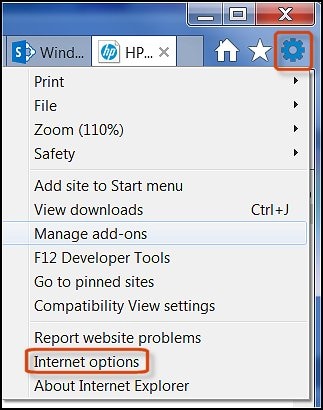
-
Click the Security tab. Click Reset all zones to default level, and then click OK.
Figure : Changing security settings

-
Try to open a PDF file.
If you still cannot open PDF files, continue to the next step.
-
-
Run the Internet Explorer performance troubleshooter and then check whether you can open a PDF file.
-
In Windows, search for and open Troubleshooting. In Troubleshooting, select View all.
Figure : Selecting View All in Windows Troubleshooting
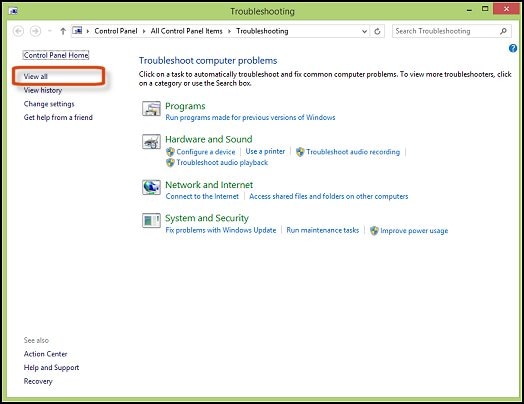
-
Select Internet Explorer Performance. Click Next and follow the onscreen instructions.
Figure : Running the IE performance troubleshooter
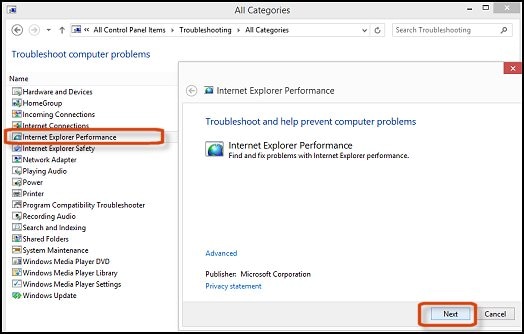
If you still can't open a PDF file, continue to the next step.
-
-
Uninstall all versions of Adobe Acrobat Reader and reinstall only one version. Multiple versions can lead to software conflicts and errors. Download and install the latest version at http://get.adobe.com/reader/otherversions/ (in English).
If you still cannot open a PDF file, continue to the next step.
-
Edit the TabProcGrowth key in the Registry using the following steps.
-
In Windows, search for and open Regedit.
-
Browse to HKEY_CURRENT_USER\Software\Microsoft\Internet Explorer\Main.
-
Look in the pane on the right to find the TabProcGrowth registry key. Double click the value and change it from 0 to 1. Then click OK.
-
Close Regedit and Internet Explorer. Reopen Internet Explorer and click the PDF link. It should now work correctly.
-
Related support for fixing Internet Explorer problems
Why Do I Have To Recover Webpage So Often
Source: https://support.hp.com/nz-en/document/c03610872
Posted by: ishmaelbobre1943.blogspot.com

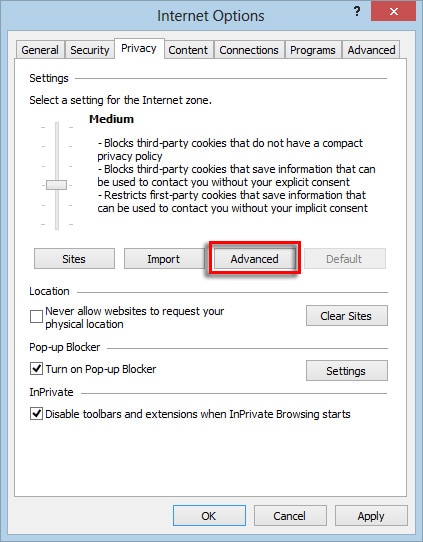

0 Response to "Why Do I Have To Recover Webpage So Often"
Post a Comment